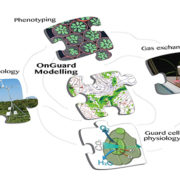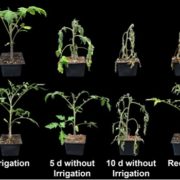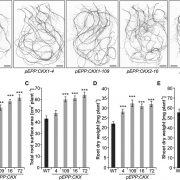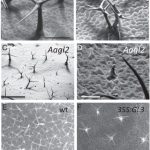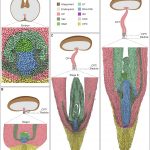Auxin-mediated statolith production for root gravitropism (New Phytol)
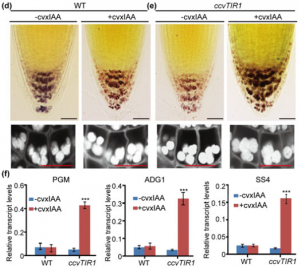 Plants have evolved the ability to perceive and respond to gravity, one of the most persistent external cues. This response process, termed gravitropism, has been extensively studied for its importance in plant development and its potential to improve agronomic traits of crops. The gravitropic response of plants is defined by three main steps: sedimentation of starch-filled amyloplasts within gravity sensing cells, the signal transduction of that sedimentation event, and asymmetric auxin distribution followed by differential growth. Zhang et al. probed auxin’s influence on the size and number of amyloplasts within the root cap of Arabidopsis thaliana. The group found that application of auxin analogues increased amyloplast accumulation and upregulated starch synthesis genes, while auxin synthesis inhibitors achieved the opposite result. Knockout mutations of auxin biosynthesis genes showed decreased amyloplast accumulation and starch synthesis gene upregulation, while mutations in auxin transport genes increased these same outputs. Furthermore, starch synthesis genes were shown to be auxin-regulated through mutations in auxin signaling pathway genes and the use of an inducible TIR1 complex. These results show that auxin may play an important role in helping plants sense as well as respond to gravity. (Summary by Nathan Scinto-Madonich) New Phytol. 10.1111/nph.15932
Plants have evolved the ability to perceive and respond to gravity, one of the most persistent external cues. This response process, termed gravitropism, has been extensively studied for its importance in plant development and its potential to improve agronomic traits of crops. The gravitropic response of plants is defined by three main steps: sedimentation of starch-filled amyloplasts within gravity sensing cells, the signal transduction of that sedimentation event, and asymmetric auxin distribution followed by differential growth. Zhang et al. probed auxin’s influence on the size and number of amyloplasts within the root cap of Arabidopsis thaliana. The group found that application of auxin analogues increased amyloplast accumulation and upregulated starch synthesis genes, while auxin synthesis inhibitors achieved the opposite result. Knockout mutations of auxin biosynthesis genes showed decreased amyloplast accumulation and starch synthesis gene upregulation, while mutations in auxin transport genes increased these same outputs. Furthermore, starch synthesis genes were shown to be auxin-regulated through mutations in auxin signaling pathway genes and the use of an inducible TIR1 complex. These results show that auxin may play an important role in helping plants sense as well as respond to gravity. (Summary by Nathan Scinto-Madonich) New Phytol. 10.1111/nph.15932


